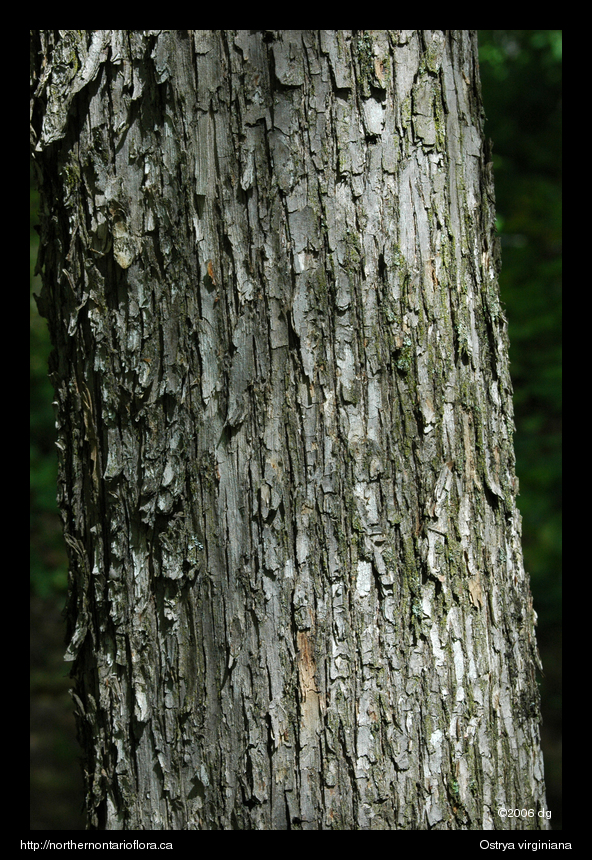
|
Northern Ontario Plant Database 
Plant DescriptionOstrya virginiana (Mill.) K.KochEn: eastern hop-hornbeam, American hop-hornbeam, ironwood
Betulaceae (Birch Family) General: A tall shrub or small tree, to 12 m tall, with very dense, hard wood; reported to have the densest wood of all Canadian trees (Farrar 1995). Bark grayish brown, furrowed, older bark separating into long narrow flakes; twigs reddish-brown, nearly smooth to glandular hairy; twig ending in a false terminal (pseudoterminal) bud; lateral buds pointing away from the twig at about a 45° angle; buds ovoid, pointed (acute), slightly hairy; bud scales several, overlapping (imbricate), scales marked with narrow, longitudinal ridges; leaf scars oval, with 3 bundle scars. Leaves: Alternate, simple, deciduous, pinnately-veined, short-petiolate. The leaves are arranged in 2 rows (2-ranked) along the stem, the leaves of the branch therefore form a flat horizontal plane. Leaf blades elliptic to ovate, 7–12 cm long; leaves green and smooth (glabrous) above, paler and hairy beneath; leaf base rounded to slightly cordate, sometimes slightly oblique; apex sharply pointed (acuminate); margins sharply double-toothed (double-serrate), with each larger tooth consisting of 2–3 small teeth; lateral veins in 11-15 pairs; petioles generally less than 1 cm long. Leaves turn yellow in autumn. Flowers: Unisexual, with separate male and female inflorescences on the same tree (plants monoecious). Sepals and petals lacking. Male flowers are arranged in long pendant catkins (aments), 1.5–5 cm long; each flower has 3 stamens and is subtended by a single bract. Female flowers occur in long, few-flowered catkins (aments); each pistil is surrounded by a bract that develops into an inflated sac around the fruit. Flowers bloom in late spring. Fruit: A small, smooth nutlet, 5–8 mm long, enclosed within an ellipsoid to ovoid, inflated bract (involucre), to 1.5 cm long; the fruiting inflorescence thus appearing similar to hops, hence the alternate common name hop-hornbeam. Fruits mature in late summer. Habitat and Range: Well-drained slopes and ridges in upland deciduous forests, very shade tolerant. Ironwood is native to the deciduous forests of eastern North America; it occurs across the southernmost regions of northern Ontario. Internet Images: The Ostrya virginiana website from the Trees of Wisconsin website. Click on the smaller images to view larger, more detailed photos. Similar Species: Twigs and leaves of Ostrya virginiana, ironwood, are similar to those of Betula alleghaniensis, yellow birch, but the ironwood twigs lack the wintergreen taste of yellow birch twigs, and their leaves have shorter petioles than yellow birch leaves, which have petioles greater than 1 cm long. The leaves of yellow birch have 9–11 pairs of veins. The distinctive shiny, bronze- to yellow-tinged bark of mature yellow birch trunks shreds horizontally into thin papery strips. Also, yellow birch produces short spur branches that bear 2 leaves; ironwood does not produce spur branches. Yellow birch is common throughout the mixedwood forests of northern Ontario, but rarely occurs farther north than the top of Lake Superior. Another similar tree, Carpinus caroliniana, the blue beech or musclewood, can be recognized by its fruit and trunk characters. In Carpinus, each nutlet is subtended by a flat leafy bract and the smooth gray trunk has muscle-like ridges, hence the common name musclewood. Carpinus caroliniana does not occur in northern Ontario, but can be found in some areas of southern and eastern Ontario. Compare ironwood to the webpages of yellow birch, Betula alleghaniensis, and blue beech, Carpinus caroliniana, from the Trees of Wisconsin website. Back to species list |
||||||||||||||||||||||














